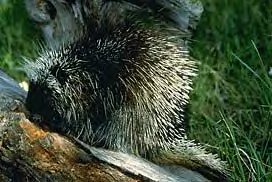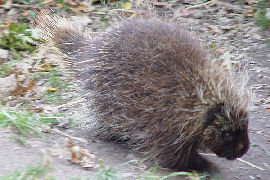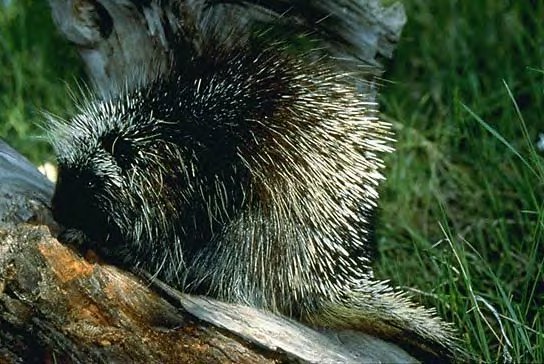Armored Mammals
Description
Large, chunky body, with high-arching back, short legs. Long guard hairs on front half of body; black or brown in the East, yellowish in the West. Quills on rump and tail. Feet have unique soles with small, pebbly-textured fleshy knobs and long, curved claws; 4 toes on forefeet, 5 toes on hindfeet. L 26–37" (648–930 mm); T 5 7/8–11 3/4" (148–300 mm); HF 3 3/8"–4 7/8" (86–124 mm); Wt 7 3/4–40 lb (3.5–18 kg).
![]()
Warning
A Porcupine may lash out with its spiny tail if approached too closely. Quills can become painfully embedded in the victim's skin. Cutting the end off the quill releases air pressure and allows it to be more easily withdrawn.
Breeding
Mates October–November; 1 young born May–June after gestation of about 7 months.
Sign
Large, irregular patches of bark stripped
from tree trunks and limbs with neatly gnawed edges, plentiful tooth
marks; "niptwigs" often strewn on the ground.
Scat: Similar to
that of deer, but the pellets vary greatly in size and appearance,
depending on food and season: in winter, rough-surfaced irregular
pellets, sometimes connected when food is relatively soft; in
summer, pellets softer, more elongate, often curved, sometimes
segmented. Accumulations found at entrances to crevice shelter or
cave among rocks and, in winter, at base of single tree where
porcupine has fed for a long time.
Tracks: Distinctive; toe in,
almost like a Badger’s; pebbled knobs on soles leave stippled
impression; long claw mark far ahead of oval main prints. Foreprint,
including claw marks, about 2 1/2" (65 mm) long; hindprint well over
3" (75 mm) long, usually but not always printing ahead of foreprint.
Stride is short and waddling, with prints 5–6" (125–150 mm) apart;
straddle up to 9" (230 mm) wide. In snow, feet may drag or shuffle,
connecting prints. Trail occasionally blurred, as if swept by a
small broom, as belly brushes ground and stiff, heavy tail swishes
from side to side in waddling walk.
Discussion
The solitary Common Porcupine is
active year-round, though in bitter cold it may den up in a hole in
a rocky bluff, sometimes with others of its species. Primarily
nocturnal, it may also rest by day in a hollow tree or log,
underground burrow, or treetop, for it is an excellent, if slow and
deliberate, climber. Yet the animal occasionally falls; about 35
percent of museum skeletons examined showed healed fractures. On the
ground, it has an unhurried, waddling walk, relying on its quills
for protection against more agile predators, although it prefers to
retreat or ascend a tree rather than confront an enemy. Long claws
are one adaptation for climbing, as they hold on to crevices in
bark. The stiff, backward-pointing quills of the underside of the
tail help keep the animal from slipping back down a tree. The tail
is repeatedly lifted and lowered as the animal descends, serving as
an exploratory organ. The Common Porcupine has about 30,000 quills
on its body; these are modified hairs, solid at tip and base, hollow
for most of the shaft, and loosely attached to a sheet of voluntary
muscles beneath the skin.
The porcupine’s generic name means "one
who rises in anger," and while a porcupine cannot throw its quills
at an enemy, when forced to fight it erects them, lowers its head,
and lashes out with its tail. If the tail strikes the enemy, the
loosely rooted quills detach easily and are driven forcefully into
the victim, whose body heat causes the microscopic barbs on the end
of each quill to expand and become even more firmly embedded. Wounds
may fester, or the quill, depending on where it enters, may blind
the victim or prevent it from eating. The short tail quills are the
most dangerous and can be driven deeply into the flesh; if they
strike a vital place, they can even cause death. But the Common
Porcupine is not aggressive; if left alone, it will not attack.
A
black line runs up the middle of the tail and expands on the lower
back, and there is white on the head. This contrasting,
black-and-white "warning" pattern is not as obvious as that of a
skunk, yet in the same way it apparently communicates to a potential
adversary that it should keep its distance. The porcupine attempts
to keep the black-and-white warning coloration of its backside
toward potential enemies. If attack is imminent, it gives a second
warning, tooth-chattering for up to half a minute, which may be
repeated many times. In addition, the porcupine can produce a
strong, pungent odor, which in confined quarters such as a porcupine
den can cause eyes and nose to water. If all else fails, the
porcupine erects its quills. A few carnivores, notably the Fisher,
are adept at flipping a porcupine over to attack its wiry-haired but
unquilled underside, but even a Fisher occasionally receives a fatal
injury.
A strict vegetarian, the Common Porcupine feeds on leaves,
twigs, and such green plants as skunk cabbage, lupines, and clover
in spring; in winter, it chews through the rough outer bark of
various trees, including pines, fir, cedar, and hemlock, to get at
the inner bark (cambium), on which it then mainly subsists. Like
many herbivores, the porcupine has bacteria in its digestive tract
containing enzymes that help to digest the cellulose and other
substances not sufficiently broken down by normal digestive enzymes.
This animal has favored feeding trees that can be recognized by
their cropped and stunted upper branches and bare wood. Another
unmistakable sign of porcupines, often littering the ground under
favorite trees, are "niptwigs," terminal branches of trees that have
been cut off and their leaves or buds eaten. In the Catskill
Mountains of New York State, sugar maples are popular with these
animals, as are young beech trees (not canopy beeches), basswood,
apple, and aspen. They also eat young ash leaves, acorns, and
beechnuts when available. Porcupines gain weight in summer and lose
it in fall. Fond of salt, the Common Porcupine has a great appetite
for wooden tool handles that have absorbed human perspiration
through use. The animal may kill trees by stripping away the bark,
and its gnawing may damage buildings and furniture.
The Common
Porcupine mates mainly in October and November; it is most vocal at
this time, giving a variety of squeaks, groans, and grunts. The
jocular answer to the question "How do Porcupines mate?" is
"Carefully." In fact, mating occurs in the same fashion as with
other mammals, but not until the female is sufficiently aroused so
that she relaxes her quills before raising her tail over her back
and presenting herself. Males may fight over females, and courtship
is elaborate. Prior to mating, the male squirts high-pressure jets
of urine over the female. After a gestation of nearly seven
months—an unusually long period for a rodent—the single young is
born in May or June in a very precocious condition. Quills are well
formed but not injurious to the mother, as the baby is born
headfirst in a placental sac and its short quills are soft; they
harden within half an hour.
The life span of the Common Porcupine is
seven to eight years. In addition to the Fisher, predators include
the Mountain Lion, Bobcat, and Coyote. Porcupine quills, both
natural and dyed, are used in brilliantly executed decorative
quillwork by Native Americans, who also eat the animal’s
flesh.




